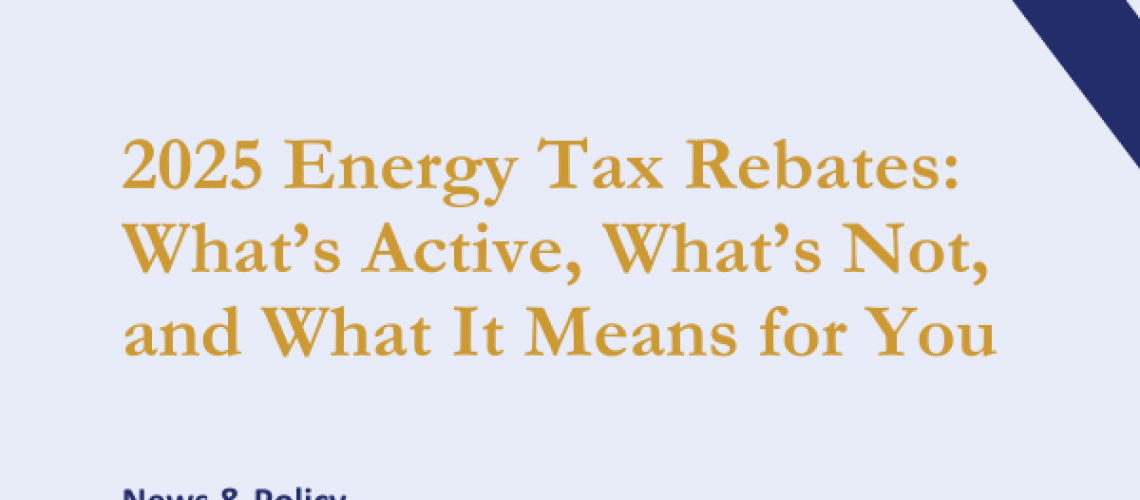With the inauguration of President Donald J. Trump, the energy sector is undergoing significant shifts. His administration has pivoted back toward fossil fuel exploration, leading to changes in tax incentives and rebates for clean energy initiatives. Some programs remain active, while others have been paused or phased out.
While uncertainty surrounds Inflation Reduction Act (IRA) funding, recent developments in Congress suggest that many key energy tax credits will remain intact for now. Additionally, ongoing tariff negotiations—particularly with China, Canada, and Mexico—signal continued political maneuvering on trade and border policy.
This blog post provides a high-level summary of our latest research memo, detailing what’s still available, what’s no longer an option, and how businesses can navigate these changes. To access the full memo, contact us for a downloadable copy.
Key Takeaways
- The latest House Continuing Resolution (CR) draft extends the budget to September, reducing the likelihood of tax credit cuts before midterm elections.
- Many clean energy tax credits remain active, including the PTC, ITC, and manufacturing incentives, despite the pause in IRA funding.
- Tariff negotiations are ongoing—China remains firm, while Canada and Mexico have secured an extension until April, indicating further political maneuvering.
- Companies should explore state-level grants and rebates, such as the Maryland Commercial Battery Storage Grant, for additional funding.
Active Tax Credits & Rebates for 2025
While IRA funding is paused, Congress has not repealed tax credits, and recent budget developments suggest they will remain available through midterms. Below are the tax credits and rebates still available in 2025.
1. Clean Energy Tax Credits
These incentives promote renewable energy generation, carbon capture, and energy-efficient infrastructure.
- Low-Income Communities Bonus Credit (Sec. 48(e), 48E(h))
- 10% credit for projects in low-income/Indian land communities.
- 20% credit for low-income building projects.
- Eligible projects must apply before August 1, 2025.
- Clean Electricity Investment Credit (Sec. 48E)
- 6% base credit for clean energy projects.
- 30% credit if Prevailing Wage and Apprenticeship (PWA) requirements are met.
- Additional 10% boost for projects using domestic materials or located in energy communities.
- Production Tax Credit for Electricity from Renewables (Sec. 45)
- 2.75 cents per kWh for commercial solar projects.
- Available for 10 years after the project starts.
- Cannot be combined with the Investment Tax Credit.
Legislative Update: A draft of the House’s Continuing Resolution (CR) includes provisions that keep PTC and other energy tax credits in place, extending the budget through September. With midterm elections approaching, Members of Congress may be reluctant to remove these incentives, making it more likely they remain in effect.
2. Commercial Clean Energy Rebates
Businesses investing in energy efficiency and battery storage can still take advantage of select state and local programs.
- Maryland Commercial, Industrial & Agricultural (CI&A) Grant
- Grants up to $400,000 for commercial battery storage and energy efficiency upgrades.
- $3.1 million available in total funding.
- New Hampshire Clean Energy Fund (Eversource)
- $250 per kWh incentive for small business battery storage.
- Maximum incentive: $10,000.
- Eligible for specific Enphase battery models.
3. Clean Vehicle Incentives
While the federal Electric Vehicle (EV) Mandate is under review, commercial vehicle credits remain in place.
- Credit for Qualified Commercial Clean Vehicles (Sec. 45W)
- Up to $40,000 per vehicle.
- $7,500 max for vehicles under 14,000 lbs.
- Available for businesses and tax-exempt organizations.
4. Manufacturing Incentives
U.S.-based manufacturers producing clean energy components still qualify for tax credits.
- Advanced Manufacturing Production Credit (Sec. 45X)
- Available for wind, solar, battery, and critical materials.
- Phases down between 2030 and 2032, but remains available through 2032.
Tariff Negotiations & Political Considerations
In addition to energy tax credits, businesses should monitor ongoing tariff discussions that could impact supply chains and manufacturing costs.
- China remains firm in its reciprocal tariff stance.
- Canada & Mexico have secured an extension until April, delaying any potential tariff increases.
- Border policy and trade remain central political issues, and further shifts could come later in 2025.
What This Means for You: If your business relies on clean energy components, infrastructure development, or international trade, staying ahead of tariff negotiations is essential.
Programs That Have Been Paused or Phased Out
1. IRA Funding Paused
The following IRA-funded programs have been temporarily frozen:
- National Electric Vehicle Infrastructure (NEVI) Formula Program
- Charging and Fueling Infrastructure Discretionary Grant Program
While funding distribution has stopped, agency heads may release funds at their discretion after consulting the Office of Management and Budget.
2. Tax Credits That Have Expired
Several key programs expired in 2024 and are no longer available:
What This Means for Your Business
While some tax incentives remain intact, others have been suspended or eliminated. Businesses should take the following steps:
- Leverage available federal tax credits for clean energy and vehicle investments.
- Explore state-level grants like Maryland’s CI&A program and New Hampshire’s Clean Energy Fund.
- Monitor political developments—as Congress approaches midterms, energy credits are unlikely to be removed.
- Prepare for possible tariff shifts, especially regarding Canada, Mexico, and China.
Get the Full Research Memo
The energy tax credit landscape is shifting, but many opportunities still exist. Make sure to act quickly and explore alternative funding sources. For a detailed breakdown of all active and inactive energy tax credits, contact us to receive a downloadable copy of our full memo.


